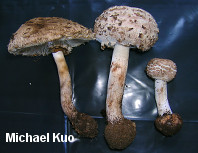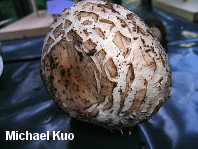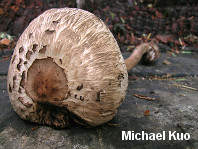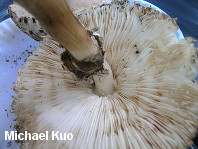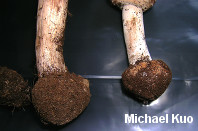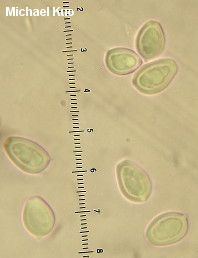| Major Groups > Gilled Mushrooms > Pale-Spored > Lepiotoid Mushrooms > Chlorophyllum brunneum |

|
Chlorophyllum brunneum [ Basidiomycota > Agaricales > Agaricaceae > Chlorophyllum . . . ] by Michael Kuo This large, impressive lepiotoid mushroom grows in cultivated areas (gardens, lawns, and so on) in western North America along the West Coast and in Denver--and, much more rarely, in northeastern North America. It is a dead ringer for the better-known Chlorophyllum rhacodes, but can be separated on the basis of its simple ring, its abruptly bulbous stem, and microscopic features, including spores that are consistently truncated at one end. Chlorophyllum rhacodes, by contrast, has a double-edged ring, a gradually thickened stem base, and spores that are both truncated and non-truncated. Although Chlorophyllum brunneum was originally described (as Lepiota brunnea by Farlow & Burt, 1929) on the basis of material collected in a Massachusetts greenhouse, its documentation in eastern North America since then is sketchy, and collections from eastern North America bearing the name "Lepiota brunnea" in herbaria might represent a hodgepodge of Chlorophyllum brunneum and Chlorophyllum rhacodes. Description: Ecology: Saprobic; growing alone, scattered, or gregariously in gardens, waste places, and lawns, or in greenhouses; sometimes forming fairy rings; summer and fall, or over winter in coastal California; common on the West Coast and in the Denver area; rare in northeastern North America (see discussion above). The illustrated and described collections are from California. Cap: 7-12 cm; convex to blocky-convex when young, expanding to broadly convex or nearly flat; dry; bald and dull grayish brown when in the button stage, but soon becoming scaly with brown to gray-brown scales; surface beneath scales radially fibrillose and whitish. Gills: Free from the stem; crowded; short-gills present; whitish; occasionally with brownish edges. Stem: 8-17 cm long; 1.5-2.5 cm thick; more or less equal above an abruptly swollen base that often features a rimmed upper edge; dry; finely fibrillose; whitish, discoloring dull brown; with a fairly tough, thick ring that is not two-layered but features a felty brown underside. Flesh: Whitish throughout; staining reddish orange to reddish or brownish when sliced. Odor and Taste: Not distinctive. Spore Print: White. Microscopic Features: Spores 9-12 x 6-8 µ; ellipsoid with a markedly truncated end; walls 1-2 µ thick; hyaline in KOH; dextrinoid. Cheilocystidia to about 50 x 20 µ; abundant; clavate; not swollen; hyaline in KOH; thin-walled. Pleurocystidia absent. Pileipellis a trichoderm (center of cap, or scales) or cutis (whitish, fibrillose surface). REFERENCES: (Farlow & Burt, 1929) Vellinga, 2002. (Vellinga, 2003a; Vellinga, 2003c; Vellinga, 2007c; Lange, 2008; Vellinga, 2008b; Trudell & Ammirati, 2009) Herb. Kuo 01161106. This site contains no information about the edibility or toxicity of mushrooms. |
© MushroomExpert.Com |
|
Cite this page as: Kuo, M. (2015, July). Chlorophyllum brunneum. Retrieved from the MushroomExpert.Com Web site: http://www.mushroomexpert.com/chlorophyllum_brunneum.html |
